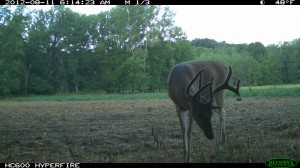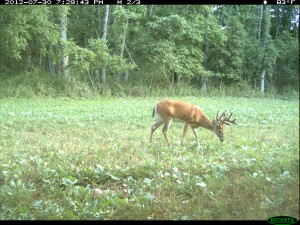Native browse
Native browse
When most hunters think habitat improvement the first thought that pops into their heads is putting in food plots. This only makes sense. After all, in many settings the greatest return on the investment of labor, time and money will be realized through a carefully planed food plot strategy. However, when creating a whitetail utopia, a robust system of food plots is only one component. To achieve the maximum benefit from this improved environment, one must also insure that fresh water is available, ample protective cover exists, that the population is held in check and that native browses abound. Well, maximizing the production of native browses is exactly what we will be talking about today.
As I have said in the past, your habitat improvement chain is only as good as its weakest link. When attempting to construct an environment that not only produces whitetails that consistently achieve their genetic potential, but holds them on the property as well, every need must be met to inspire them to stay at home. This is as true for their seasonal needs as it is of their daily needs. For example, It may be all well and good to have a bounty of nutrition during the summer and fall months, but to maximize the health of the whitetails, as well as antler size, weight and reproductive success, they need adequate levels of nutrition all year round.
Dr. Karl V. Miller, professor of wildlife ecology and management at D. B. Warnell School of Forest Resources agreed regarding the importance of year round nutrition. “Yes, supplying quality nutrition during each season is very important in allowing deer to achieve their full potential,” he said. “Many hunters concentrate on summer and fall food plots when antlers are growing and does are nursing fawns. While these are very important, quality food sources during winter and early spring can be equally important. While deer don’t ‘grow’ during winter, quality foods will help bucks recover body condition following the rut, and allow both bucks and does to enter the spring in better condition. And, better spring condition likely will translate into higher fawn survival and growth as well as better antler production.”

Native browse research
Taking it a step further, to protect them and increase our abilities to manipulate the sex and age structure of the herd, the more time they spend on our property the better. Having all their needs met during every season helps greatly in those efforts. Keith McCaffrey, a retired Whitetail Research Biologist with Wisconsin’s Department of Natural Resources, agrees. He has told me more than once that, ‘if an area contains a superior level of forge and cover, when compared with the surrounding area, whitetails will be drawn to the area and spend a disproportionate amount of their time there during the non-breeding periods of the year.’
Increasing the yields and quality of native browses is one way to help accomplish this. To do so it is helpful to view natural forages much like farm crops. Like farm crops, there are things we can do to increase their productivity. Just about every food source will benefit from a few simple tasks. These include things such as reducing competition, providing optimum levels of sunlight, maintaining adequate moisture, ensuring proper soil fertility, and maintenance of the crop itself. In almost every case, we can have a positive effect on all or a combination of these factors. Although there is no way one article can cover every situation, by breaking down three common examples one should be able to see how they can apply these techniques to almost any native food source.
Increasing Mast Production in native browse
To begin with, lets explore oak trees. Most hunters realize that acorns are an important food source for deer in the areas that they exist. What some don’t realize is that we can have an impact on the mast crop available to deer. Although various species of oaks exist, they all have one thing in common. Oak trees are fruit trees. Much like a fruit farmer, we can take steps to increase the size and quality of the oak’s fruit crop.
It begins by fertilizing selected oaks. This can be as easy as following the directions on a box of fruit tree fertilizer spikes. However, using granular fertilizer is often a less expensive method. When using granular fertilizer, the first step is raking the debris from the base of the oaks on out to the drip line. The drip line itself is the imaginary line that forms a circle around the tree. It is line on the ground that mirrors the outer tips of the branches. Once the raking is concluded we can then apply a 10-10-10 to 15-15-15, slow release fertilizer. Beginning a couple feet from the base, a medium dosage is spread evenly around the entire tree and out to the drip line. Just like that, we have increased the nutrients available to the trees. This, in turn, can result in a better fruit crop.
Whichever method is selected, fertilizing should be done in the spring of the year. Doing so provides extra nutrients through the developmental stages of the crop. Also, in northern settings, fertilizing in summer or fall can have detrimental effects. The burst of fertility can prompt trees to spur new growth too late into the fall. The result can be frost damage to this tender growth and provide unnecessary stress.
Another technique that can be very beneficial is thinning the canopy of less desirable trees. Trees require sunlight to perform photosynthesis (the act of producing food). Think about where most of the largest, healthiest trees are located. They are generally found in open areas. Open areas allow them to receive adequate levels of sunlight. This not only has the potential to result in increased growth, but it helps to ensure that the lower branches receive adequate sunlight for survival. Removing some of the less desirable trees that shade our selected oaks brings on the same effect.
Finally, we can even aid them in maintaining soil moisture. After we have fertilized, we can rake extra leaves back on to the area. If sufficient leaves are not present, straw will also work. This aids in moisture retention by providing a barrier between the ground and the baking sun to lessen evaporation.

Despite this section’s focusing specifically on oak trees, these procedures can be applied to any mast producing tree (apple, cherry, beechnut, etc.). The net result will be the same. Healthier trees that are capable of increased crop production. As the effects of our efforts begin to pay off, deer will begin gravitating to the “healthier” trees. Because of this, the deer benefit from increased forage and the hunter is able to more accurately predict where feeding will occur.
Putting greens on the table with native browse
Lets now look at the overgrown meadows that are found on so many properties. These often overlooked food sources are the backbone of many habitat’s food production capabilities. Keith McCaffrey studied the importance of these forest openings during his time with the Wisconsin DNR and fully appreciates the role they play in a whitetail’s diet. “The cool season grasses and forbs found in relic forest openings (old fields or camps) provide critical deer forage in northern Wisconsin,” Keith said. “These grassy openings are especially important in the absence of mast crops.”
Beyond simply having or creating these openings, we can increase their desirability. Greenery does not output the same levels of digestibility and nutrition throughout its growth cycle. Much like a farmer’s alfalfa crop, as grasses and forbs reach maturity their cell walls harden, making them more difficult to digest. At the same time, the protein levels they had produced while rapidly growing spiral downward as they reach maturity. The more digestible plant matter is the more nutrition deer are able to derive from it. Because of this, digestibility can play as key of a role in the value of a plant as nutritional content. Steps may be taken to improve this situation.
To begin with, a safely conducted spring burn can be a good first step. In order to safely perform a controlled burn, firebreaks should be created along the boundaries of the burn area. This can be accomplished in several ways, but I have found that thoroughly discing a 10 yard swat around the burn area is an effective tactic. Also, it is highly recommended that the burn be supervised at all times. Burning down the entire forest may eventually result in better habitat, but the firefighters can get a touch testy.
Next, we can apply a lawn fertilizer in the same manner we would to our own front lawn. Like the oaks, this can result in healthier plants that are capable of increased production. Unlike with the oaks, this act should be conducted both in the spring and early fall. This act alone increases the plants nutritional value and yield. To increase both further we can mow them as they begin to reach maturity. Doing so will keep the plant life from ever reaching maturity and the inevitable drop in production that brings. The combination of these acts result is a dramatic increase in quality and production. Mowing 2 or 3 times a year is usually sufficient. Once the plant life nears maturity, its time to mow again.
Those simple procedures can produce an increased level of high quality forage. As Dr. Miller stated, “While there has not been a lot of research on the subject, in some cases both the yield and nutritional quality of native browses can be manipulated. Fertilizing native browses often increases the production and nutritive quality of deer forages, particularly if it’s done in an open area. Seasonal disking or bushhogging of fields also works to stimulate production of deer forages, but results will vary from area to area, and region to region.”
Not only can these acts benefit deer, but they can be a huge benefit to us as hunters as well. In most of the whitetails range, at least part of hunting season overlaps a period when fresh greenery is woefully lacking. By prolonging the growth cycle, these meadows are able to keep producing until snow or drought finally drives them into dormancy. Before that occurs, there is often a period where our treated meadows contain the only native grasses and forbs that still hold substantial drawing power over deer. Obviously, this can result in great stand sites.

A final consideration is often that we are striving to focus deer activity and retain a diverse habitat, as well as increase forage production. Because of this, it is not prudent to treat a 40-acre field in this manner. Not only will that have a negative impact on game bird nesting and fawn rearing, it also provides the deer with too large of an area to feed. That can be a draw back when trying to bow hunt a meadow. It is often better to have several 1-5 acre patches than one big one.
Increasing Woody Browse for native browse
Lastly, lets look at woody browse. As many studies have indicated, woody browse constitutes a substantial portion of a whitetail’s diet. This is even true in agriculturally rich areas. Therefore, it only stands to reason that increasing its yield and nutritional values will be of benefit to both the habitat managers and whitetail populations a like.
As with everything else we have covered, applying fertilizer will aid in increasing its health. We can also apply the same clearing principle we discussed for the oaks. Removing mature trees that block sunlight will encourage browse production. Finally, we can also trim them, much like a hedge. This is a method of extending the time in which the browse they produce is at a level where deer can reach it. Also, it creates more shoots then it normally would. Thus, providing extra browse for the whitetails.
In mature woods, where ample woody browse does not exist, it is undeniable that proper logging techniques can increase the amount of food produced per acre. Again, Dr Miller concurred with this. “Certainly, some type of timber stand manipulation will stimulate understory browse production,” said Dr. Miller. “I’d suggest you contact a biologist from your state agency for the best techniques in your area. Perhaps even better, why not go out and experiment on your own?”
My favorite method is to employ a clear cut/selective cut hybrid in mature sections of woods. The goal is to supplement our existing food sources, not to replace one with another. Because of that, I am always hesitant to remove mast trees unless they are in such abundance that they dominate the area. In a typical scenario, removing all but mast producing trees, desirable trees for seeding and selected ones for treestands, works well. To maintain diversity, I have found 5-10 acre areas to be ideal. This creates pockets that allows for increased mast production and opens the forest floor to sunlight. This new sunlight spurs all sorts of new growth, ranging from grasses to berries to new saplings. The result is a dramatic increase in forage production and a year round food source.
As the clearing matures, we can apply the same trimming and fertilizing principles to extend their production. Eventually, the area will need to be cut again. What we have just done is create a circle of actions that can be repeated over and over. Through proper planning, a series of these areas can be maintained, each in a different stage than the others. With this in place, we eliminate the boom and bust that occurs when either only one is in place or they are all in the same growth stage.
Conclusion
native browse is just one of the factors that must be addressed in creating our whitetail utopia, but it is an important one. By looking upon them as farm crops, we can begin to understand how we can boost their productivity by using many of same methods that crop and fruit tree farms utilize. By doing so, not only can increase the amount of nutrition our properties have to offer, but we can fill in some of the seasonal gaps that many food plot strategies do not address. The more gaps we can close, the more success our habitat improvement plans will realize.

Lastly, we must remember that a diverse habitat has the ability to be far more productive than one that is the same throughout. Granted, certain agricultural crops are a source of great nutrition, but they need compliments. A piece of land that consists of a sampling food plots, meadows, mature woods, saplings, thick tangles and thriving mast crops, along with a good water source, will almost always support more deer than a homogonous setting. Promoting a variety of native browse production takes us yet one step closer to creating that perfect piece of hunting ground.

